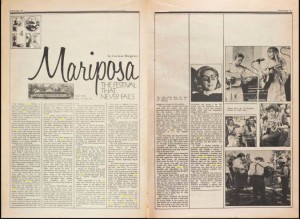
An article written about the Mariposa music festival featured in Rock Magazine. 1972, Vol. 3, Issue 10
The folk music revival was carried by and largely served the young men and women who were raised to volunteer, organize civil rights protests and activist groups and work with political powers (at least at the start) to effect the change they envisioned for the world. These college-age individuals rejected commercial mass culture while they favored borrowing and adapting older music from previous generations to serve their own purposes.
During the 1970s, there was a boom in music festivals. Occurring over the span of 3-12 days, festivals became the best place to discover new artists, interact with new like-minded people and share new ideas about politics and the world. (They were also associated with drug use, but that’s not the focus of this article.) Festivals were generally grassroots efforts, organized by local communities, regionally or nationally and could have an educational focus. “The Mariposa Folk Festival in Toronto, Canada is one of the biggest in North America. [In the summer of 1972] it broke even and its organizers were happy.”1
Many different artists came to the festival to perform the music that was shaping the mentality and ethos of the college-attending generation in 1972. Old folk tunes were repurposed, given new life with new words about the ideas and emotions of the heartbroken and those downtrodden by society.2
“In 1965, a young folk singer named Joni Anderson hitchhiked to Mariposa from Calgary and in 1970 she drew 12,000 to a night concert because she was the famous Joni Mitchell … [James] Taylor was asked to Mariposa because ‘he has a lot of roots in folk’ not because he would draw people. Taylor came because he wanted to, not for the money, which amounted to $75. That is the most any performer is paid, along with his traveling and accommodation expenses. Why? Because Mariposa is an annual gathering of balladeers, not a rock festival.”
Today, we still see (or hear of) people borrowing from other musical ideas and traditions. What they borrow leads to commercial success––in the case of Amy Winehouse and Iggy Azalea. Artists borrow ideas for several reasons: they identify with some aspect of the idea or culture, to make money, necessity demands that they adapt their music to today’s pop standards by updating the sounds or affect they use, or, to make a statement. We are in a never ending cycle of cultural repetition. Everything we produce and consume will reoccur in another form some time (shortly or long after) the “original” was produced. However, the questions have not changed from the 1970s when the folk music revival was in full swing, nor from when bluegrass was in its developmental stage as a musical genre. What is the intent behind artist’s borrowing ideas from others and how many alterations must the new work undergo before it is something original? Is there a way to respectfully reproduce or change something when you yourself have not been around to experience the genesis of that idea or have little to no connection with that cultural movement, people, or idea? And what is the significance of festivals? What role do they play with the appropriation, adaptation and spread of ideas and are they important cultural hub or a temporary collection of society’s social outcasts and wannabe reshapers?
The Mariposa music festival still is around today. This year, the festival’s dates are July 3-5, 2015.
1. Musgrave, Corinne. “Mariposa: The Festival That Never Fails.” Rock, 1972 3, no. 10 (1972): 20-21.
2. Crawford, Richard. America’s Musical Life. New York: W. W. Norton & Company, 2001.
